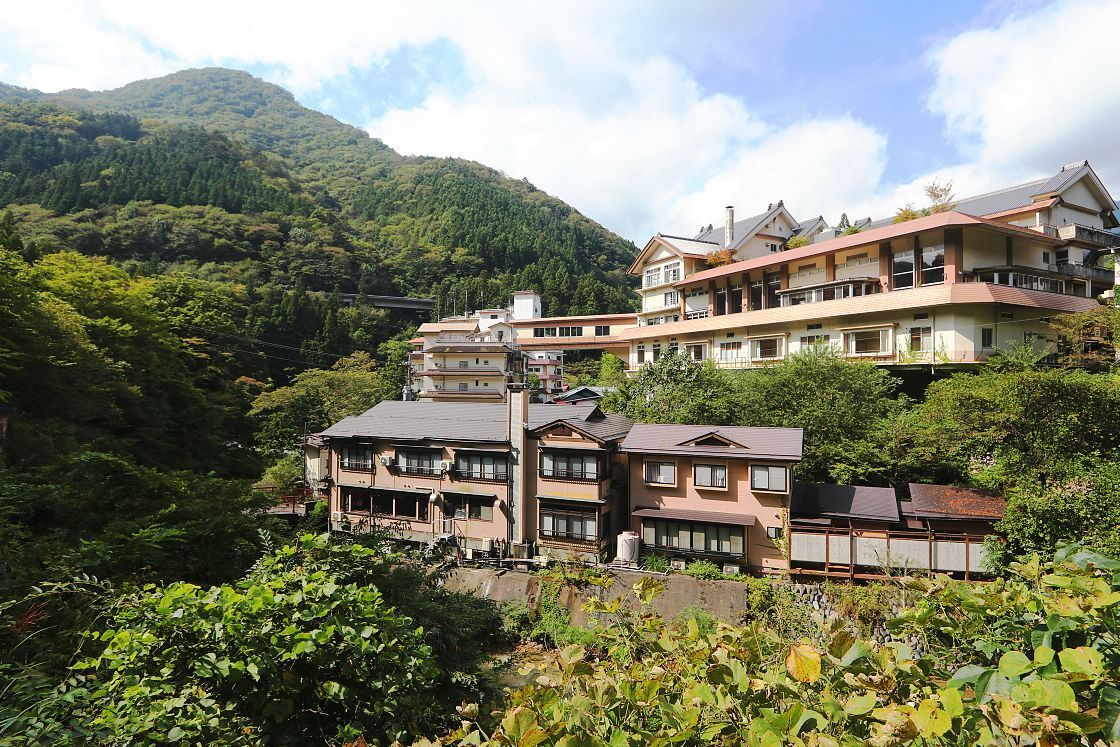An overnight escape to Shima Onsen
Located just under three hours from Tokyo in the mountains of northwest Gunma Prefecture, Shima Onsen is a peaceful hot spring town whose seclusion, unspoilt atmosphere and stunning backdrop of forests, mountains and lakes make it the perfect destination for a short getaway.
For visitors like me with limited Japanese, getting the most out of a first-time trip to a relatively off-the-beaten-track destination can be something of a daunting prospect. Fortunately however, Gunma's official travel website provides lots of useful information to plan your trip, from accommodation and activities to example itineraries - one of which was easily adapted into this very article. The site even features its own handy trip planning tool, allowing users to drop sites of interest into a wishlist and plot out their time in the most efficient way possible.
For my own visit, I managed to pack a surprising amount into a two-day itinerary from exciting outdoor activities to local cuisine, while of course making the very best of the famous local hot springs.
Day 1
After a two-hour journey by shinkansen and local line from Tokyo, I took a bus from Nakanojo Station for the final 50 minutes along a winding stretch of narrow mountain road.
Arriving at the lower part of town, I was immediately struck both by the beauty of the surroundings and the incredible quiet, broken only by the occasional passerby and the constant flow of water. With late summer giving way to early fall, the air was humid but beginning to cool, and while a typhoon churned uncertainly nearby, the sky was relatively bright and clear, at least for now.
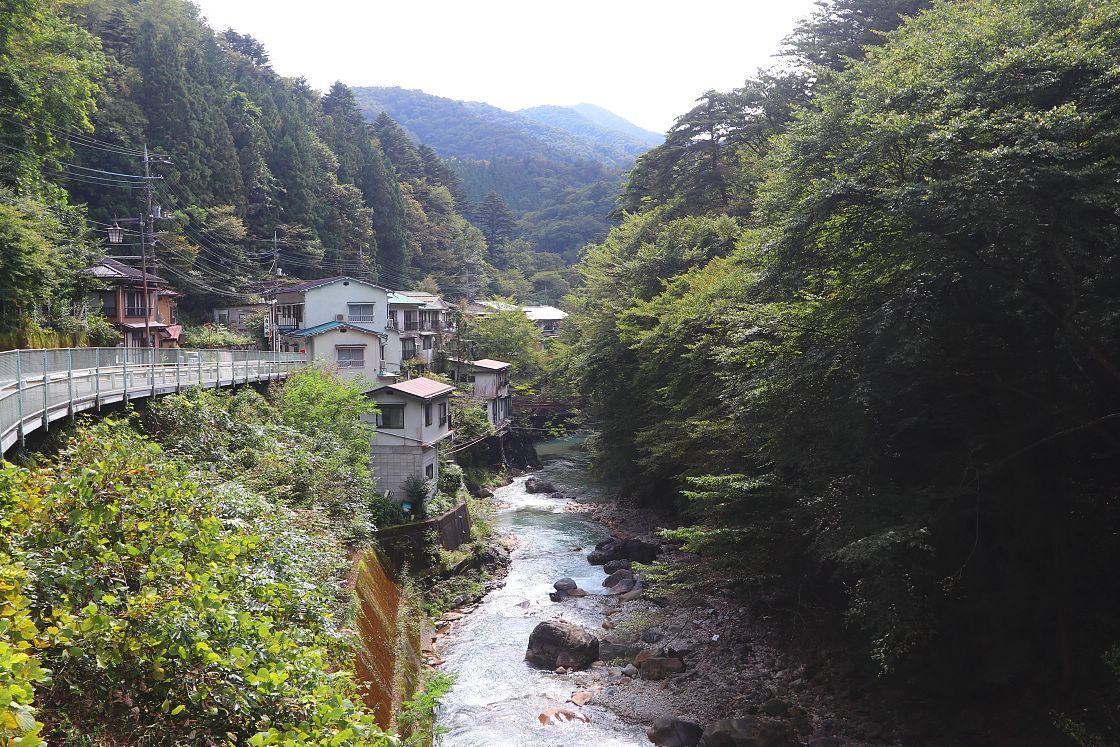
Divided into three distinct parts, the town takes the form of a narrow strip following the course of the Shima River. As I approached the middle, ryokan inns and homes gradually gave way to a narrow main street, with various shops, eateries and an attractive cafe.

A little further along, the town widened into an area of several interconnected streets where the Shima River met the Arayu flowing from the northwest. Here, I arrived at perhaps the area's most iconic sight - the beautiful wooden exterior of the Sekizenkan, a 300-year-old ryokan known for its Taisho-era bathhouse.

With time to spare, I spent a pleasant half hour meandering through the area's narrow streets, finding more ryokan inns, shops and an old amusement arcade with rows of ancient pinball machines.
From a bridge at the western edge of town, I took a moment to enjoy the sight of a waterfall with the Shima River snaking off into the forest beyond, before climbing a few hundred meters uphill to catch a commanding view of the larger hotels framed by forested mountains.

By now it was lunchtime, so I threaded my way back through the town to Asunaro, a little family-run restaurant tucked away between a bus shelter and one of the larger hotels. Here, pork cutlets are a popular local choice, but I opted for the cheekily named signature dish of Danbei Meshi, a phrase meaning something like rice, isn't it
in the distinct local dialect.
As well as a generous portion of rice, this turned out to include servings of shredded egg, chicken, green onion and crispy seaweed for me to mix together, topped off with a pouring of dashi stock. It was delicious, filling, and somehow not quite like anything I'd had before.

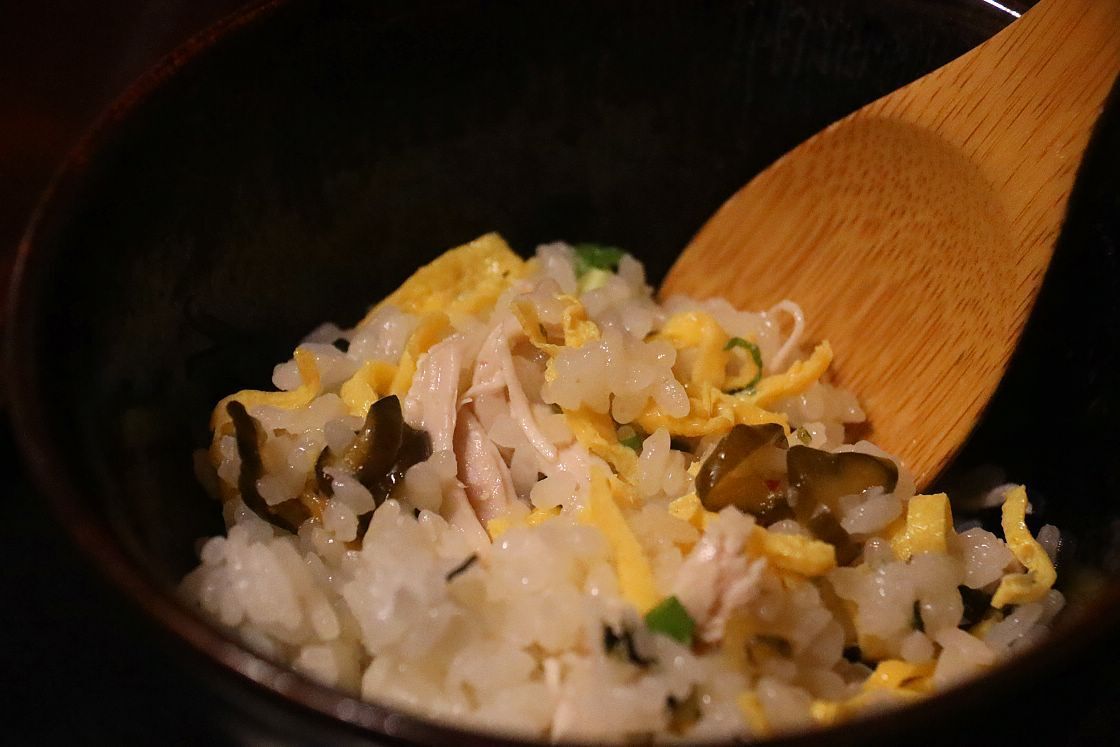
After the meal, I took a short stroll across the river and into the woods to Green Discovery, a local tour operator offering a range of water-based activities. Today I was especially excited to try canyoning - scrambling, sliding, swimming and even jumping downriver over slippery rocks and fast-flowing water - for the very first time.
After a quick briefing, I changed into a wetsuit and jumped into a van with Tetsuji-san, my guide for the day, for a five-minute drive to our starting point upriver. Hopping over a fence and making our way down the steep valley slope, it was time to wade out into the water.
The water might have been the perfect way to escape the summer heat just a week or two before, but by now the temperature had already begun to fall and the first icy flush of water down my back came as something of a shock!

Fortunately, as soon as we began to move - picking our way over rocks, sliding over little waterfalls, swimming through smaller pools or simply letting the current take us - the sheer excitement was more than enough to keep me warm.

In what seemed like no time at all, we arrived at the final plunge of the course, sliding over the Oizumi Waterfall into churning whitewater, emerging some distance away in a deep and dazzlingly blue pool - a big finish to a hugely exciting experience.
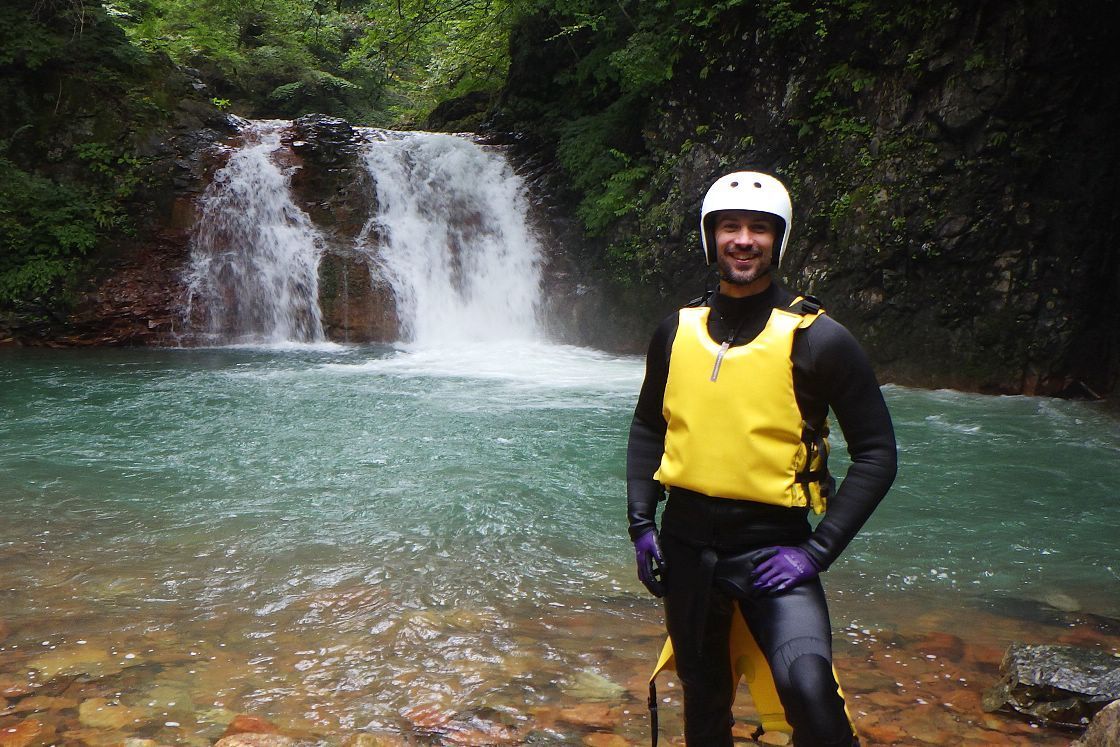
After saying my goodbyes to Tetsuji-san, I retraced my steps to the middle of town and took a bus about three kilometers south to the Shima Potholes - a series of deep rock pools worn into the bed of the Shima River over thousands of years.


Found at a twist in the riverbed and surrounded by formations of weathered rock, the pools are especially eye-catching due to their shimmering blue color, caused by a volcanic mineral called allophene that infuses the local hot spring water.


Making my way back to the lower section of the town, I checked in at the Kashiwaya Ryokan - an elegant hot spring inn and my accommodation for the night. From the moment I stepped inside, I felt enveloped by the inn's peaceful atmosphere, with warm, attentive staff, the sound of soft, tinkling Jazz and a pleasant, Taisho-inspired decor.


The cozy feeling continued into my guestroom, which was very nicely furnished and contained one of the most comfortable beds I've ever come across in a traditional overnight stay.

After a short rest, I changed into my yukata eveningwear and made my way back downstairs to the dining room where I was to be treated to a multi-course kaiseki banquet.
The meal began in spectacular fashion, with a selection of beautifully prepared, bitesize morsels, each offering their own tantalising glimpse into local ingredients and seasonality - from the high-grade "Ginhikari" rainbow trout that is a Gunma specialty, to the fresh bonito returned at the start of autumn from colder ocean waters with a thick fatty coat.

This first course was soon followed by a whole series of equally spectacular ones, and while there were too many special moments to list them all, two particular highlights were four pieces of local Joshu beef sizzling away on a hot stone, and delicate slices of octopus and scallop artfully presented with fall vegetables inside a hollowed-out apple.


Feeling hugely satisfied, I decided to go for an evening stroll and take in something of the town at night before settling in ready for another day of exploring. Making my way back along the river to the main central area, I found the Sekizenkan looking spectacular with its evening lights on.
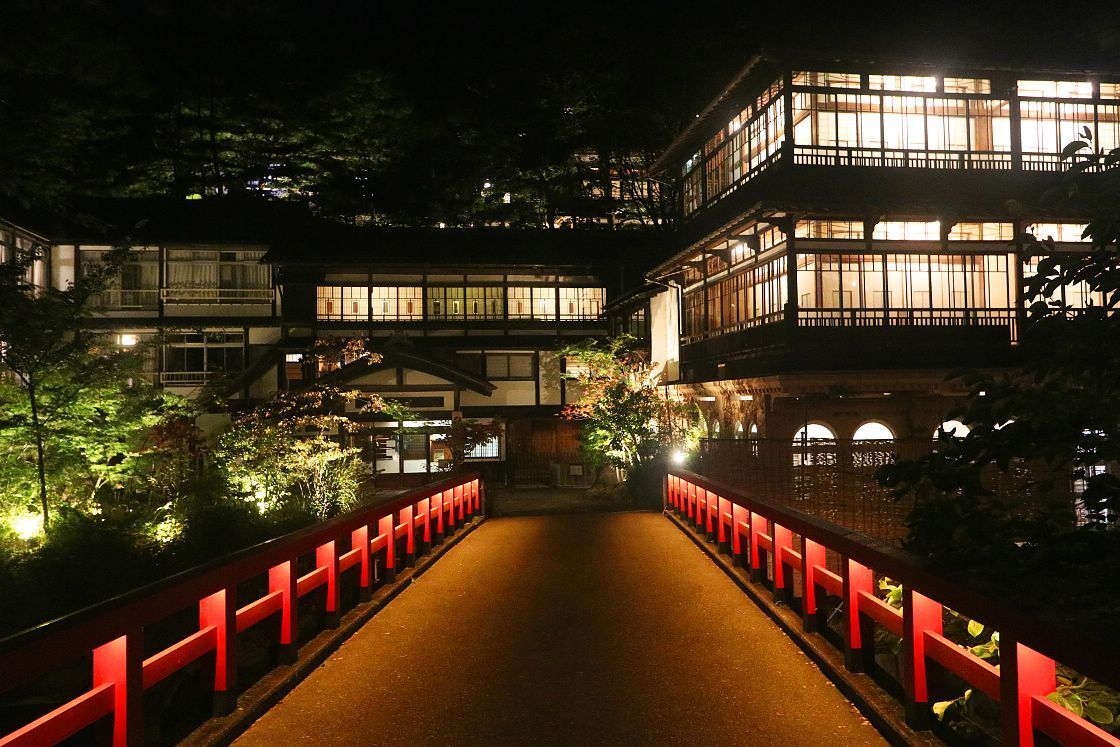
Back at the ryokan, it was finally time to take a dip in the town's famous hot spring water. As well as two gender-separated public baths, I found three private outdoor baths on the upper floor available on a first-come, first-served basis. The system for these, I discovered, is very easy to use - just slip inside, lock the door behind you and a light comes on at the entrance to show that it's taken.

Maple

Sakura
Each of the three baths felt wonderfully secluded. While the first two, named Maple and Sakura, featured their own little rock gardens and namesake trees, I especially enjoyed the one called Moon - a circular wooden tub, simply decorated with bamboo, that somehow felt the most luxurious of all. Feeling supremely relaxed, I headed back to my room and was soon sound asleep.

Moon
Day 2
The next morning, after a delicious breakfast combining western and Japanese elements, it was time to head out for my first stop of the day. Located just a few minutes walk away on the opposite side of the river, the Seiryu No Yu is a popular public hot spring for day visitors, known for its attractive outdoor baths with views of the surrounding scenery.
Making my way through to the outdoor baths, I slipped into the hot, mineral-rich water and enjoyed a long soak in the crisp outside air. A light film of rain had fallen early that morning, and mist rose from the surrounding treetops giving the view an entirely different, more atmospheric feel.



Getting ready to leave, I paused for a moment to take in the view of the river from a veranda, and a cosy space for guests to unwind after enjoying the baths. Tempting as it was, for me it was already time to make my way to the middle part of town for my next appointment.


Arriving with a few minutes to spare, I decided to repeat my detour from yesterday - crossing the river and heading a short way uphill. From there, I got a very different view of the town, with the forest backdrop shrouded in mist.

Next on my itinerary was an early lunch at Yakuzenya Mukoshin, a health-focused restaurant located in a beautifully renovated teahouse. The building dates to the late 17th century and is designated an Important Cultural Property.

Inside, the space is bright and airy, with carved wooden furniture and large, open windows facing towards the Sekizenkan on the opposite side of the river. Reflecting its mission of serving healthy, wholesome food, the decor is reminiscent of a traditional apothecary, with rows of herbs, spices and preserves displayed prominently in glass jars.


Taking a look at the menu, I decided on the daily special of samgye-tang - a traditional Korean dish of rice porridge with chicken, jujube, garlic and ginseng. It was delicious, nourishing fare, leaving me energized and excited for the final stop on my itinerary.
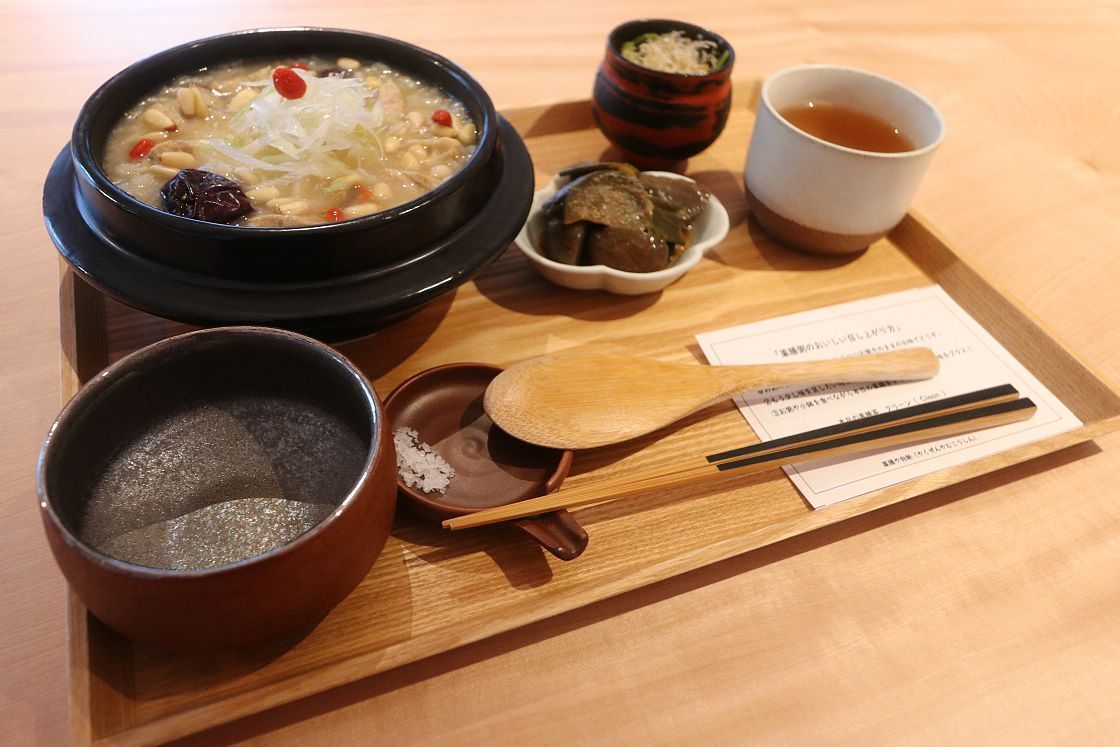
A twenty-minute bus ride to the south of town I arrived at Green Peace Gunma, another outdoor tour operator offering a range of activities on nearby Lake Shima. My guide for the day was Ryu-chan, a bright and friendly character with a clear passion for the local environment.
Having just avoided another light shower, we each donned waterproof outerwear before jumping in a van for the brief drive down to the lake, where a pair of lightweight canoes were waiting on the shore. After a quick demonstration of the correct paddling technique, we were soon making our way out into the water, delighting in its striking blue-green color and the surrounding landscape.The sense of stillness, broken only by birdsong and the quiet trickle of water over our paddles, was breathtaking.


With his easy charm and impressive local knowledge, Ryu-chan soon turned out to be the ideal travel companion, effortlessly pointing out unseen birds from the sound of their calls, and sometimes drawing me to one side to introduce various flowers and trees. As we chatted away, I was impressed to learn how the lake reveals a different kind of beauty in each season, and promised myself that I would return to experience it again, perhaps in winter or spring.

After at last making our full-circle around in the lake in a long, leisurely circuit, it was finally time to return to shore and say our goodbyes. It had been the perfect ending to my time in Shima Onsen, an experience that was relaxing, invigorating and somehow transcendent, surrounded by natural beauty.

Access
From Tokyo, head to Ueno Station and take the JR Kusatsu Limited Express to Nakanojo Station (50 minutes, around 4500 yen, 2-3 departures per day). From there, change to a local bus for the remainder of the journey (50 minutes, 950 yen, departures every 40-70 minutes).
For more frequent departures, take the shinkansen from Tokyo to Takasaki Station and change to a local train for Nakanojo (about 130 minutes, around 6000 yen, departures every 1-3 hours).
Alternatively, take a Kan-etsu highway bus from Tokyo's Yaesu Exit direct to Shima Onsen (3.5 hours, 5200 yen for a round-trip ticket, 1-2 departures per day).
